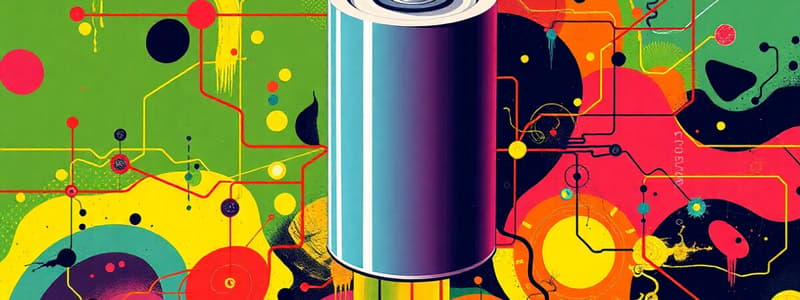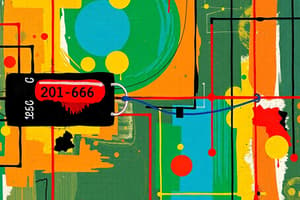Podcast
Questions and Answers
What is the definition and unit of magnetic dipole moment?
What is the definition and unit of magnetic dipole moment?
- It's a measure of the energy stored in a magnetic field, measured in henries.
- It's a measure of the torque experienced by a magnetic dipole in a magnetic field, measured in joules.
- It's a measure of the magnetization per unit volume, measured in ampere-square meters. (correct)
- It's a measure of the strength and orientation of a magnetic source, measured in coulombs.
Which of the following best defines microwaves?
Which of the following best defines microwaves?
- Waves with wavelengths ranging from 1 mm to 1 m.
- Electromagnetic waves that have frequencies between 300 MHz and 300 GHz. (correct)
- Waves that can only be generated by natural sources.
- Waves that can only travel through vacuum without any medium.
What does the angle of polarization refer to?
What does the angle of polarization refer to?
- The angle between the electric field vector and the direction of wave propagation. (correct)
- The angle at which light is refracted through a prism.
- The angle at which a wave encounters a boundary between two media.
- The angle at which sound waves travel through different mediums.
What type of diode is mentioned in the provided diagram?
What type of diode is mentioned in the provided diagram?
How is one henry self-inductance defined?
How is one henry self-inductance defined?
What is the definition of current density?
What is the definition of current density?
What is the relation between the velocity of a charged particle and the potential difference according to the formula derived?
What is the relation between the velocity of a charged particle and the potential difference according to the formula derived?
What is displacement current?
What is displacement current?
What is the equivalent capacitance when two capacitors C₁ and C₂ are connected in series?
What is the equivalent capacitance when two capacitors C₁ and C₂ are connected in series?
Which of the following statements is true regarding the attractive and repulsive forces between parallel current-carrying conductors?
Which of the following statements is true regarding the attractive and repulsive forces between parallel current-carrying conductors?
What is the required condition for a series L-C-R circuit to be in resonance?
What is the required condition for a series L-C-R circuit to be in resonance?
What is the significance of Einstein's photoelectric equation?
What is the significance of Einstein's photoelectric equation?
What happens to the photoelectron's kinetic energy when a photon of energy 1 eV strikes a metal with a work function of 0.5 eV?
What happens to the photoelectron's kinetic energy when a photon of energy 1 eV strikes a metal with a work function of 0.5 eV?
Which correctly describes displacement current?
Which correctly describes displacement current?
Which is true regarding the capacitance ratio C₁ to C₂ if their equivalent capacitance in parallel is 20 µF?
Which is true regarding the capacitance ratio C₁ to C₂ if their equivalent capacitance in parallel is 20 µF?
How do charges flow in a resonant L-C-R circuit?
How do charges flow in a resonant L-C-R circuit?
What defines the magnetic dipole moment in a magnetic field?
What defines the magnetic dipole moment in a magnetic field?
Which relationship provides a measure of the ratio of kinetic energies of photoelectrons k₁ and k₂ when different photon energies impact a metal plate?
Which relationship provides a measure of the ratio of kinetic energies of photoelectrons k₁ and k₂ when different photon energies impact a metal plate?
Flashcards are hidden until you start studying
Study Notes
Capacitors and Their Configurations
- Two capacitors with capacitances C₁ µF and C₂ µF have a combined capacitance of 20 µF when connected in parallel.
- When connected in series, their total capacitance is 4.8 µF.
- The ratio of capacitances C₁ and C₂ can be derived using the formulas for series and parallel combinations.
Forces Between Current-Carrying Conductors
- The force between two parallel, straight current-carrying conductors can be attractive or repulsive.
- The force is attractive when currents flow in the same direction and repulsive when they flow in opposite directions.
- This behavior is due to the magnetic fields generated by the currents interacting with each other.
Resonant Circuits
- A resonant circuit, commonly called an L-C-R circuit, has specific conditions for resonance: impedance must be minimum, and the inductive reactance must equal capacitive reactance.
- The expression for the resonant frequency is given by: ( f = \frac{1}{2\pi\sqrt{LC}} ), where L is inductance and C is capacitance.
Einstein's Photoelectric Equation
- The equation describes the photoelectric effect, showing that the energy of photons (E = hf) exceeds the work function (φ) of the metal.
- For a metal plate with a work function of 0.5 eV, photons with energies of 1 eV and 2.5 eV yield maximum kinetic energies for emitted electrons represented as ( k₁ ) and ( k₂ ).
- Ratios ( k₁/k₂ ) and ( v₁/v₂ ) can be calculated based on the energy of the incoming photons minus the work function.
Magnetic Torque on a Current Loop
- The formula for torque acting on a current-carrying loop in a uniform magnetic field can be established from the concept of magnetic moment.
- Magnetic dipole moment is defined as the product of the current flowing through the loop and the area vector of the loop.
Definitions and Concepts
- Displacement Current: Introduced by Maxwell, it accounts for changing electric fields in situations where conduction current may not flow, influencing electromagnetic phenomena.
- Microwaves: A type of electromagnetic radiation, classified based on wavelength and frequency, used in applications like microwave ovens and communication technologies.
- Polarization Angle: Refers to the angle at which the electric field vector of a light wave oscillates relative to its propagation direction.
- p-n Junction Diode: Can be forward or reverse biased based on the connection of the p-type and n-type materials; used in various electronic applications including rectification.
- Henry: A unit of self-inductance when a change of current of one ampere induces an electromotive force of one volt.
- Current Density: Defined as current per unit area of cross-section, represented in units of A/m².
Additional Calculations
- Equations relating to the drift speed and potential difference can be derived for conductors.
- The ratio of de Broglie wavelengths for proton and α-particles, kinetic energy relationships, and definitions of mass defect and binding energy are critical in nuclear physics.
- Current flowing through a circuit, given as 5 mA, can be utilized to find the resistance using Ohm's law, based on applied voltage drops in the circuit.
Studying That Suits You
Use AI to generate personalized quizzes and flashcards to suit your learning preferences.




